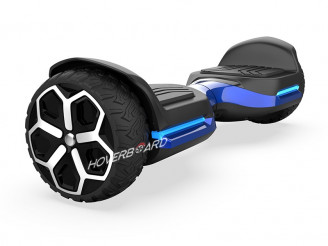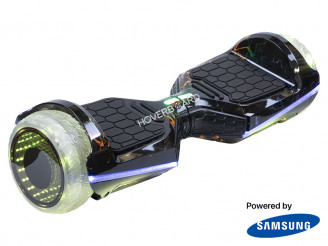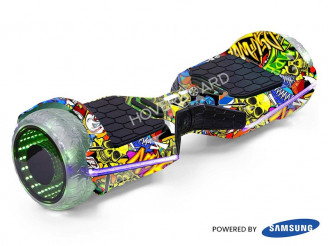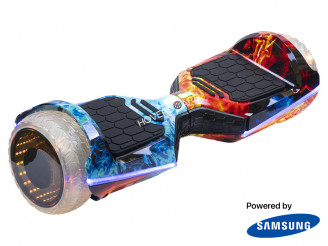For numerous individuals, the word "hoverboard" brings to mind scenes from "Back to the Future" – a board genuinely floating above the ground. Although today's consumer "hoverboards" are essentially self-balancing scooters equipped with wheels, their clever design offers an experience that closely mimics gravity defiance. Grasping their functionality requires an intriguing mix of physics and advanced electronics.
Dispelling the Levitation Myth (for most consumer models)
It's important to emphasise that the typical "hoverboards" available on the market today do not truly hover using electromagnetic levitation like a Maglev train. Rather, they utilise an ingenious combination of sensors, motors, and a control system to keep balance and react to the rider's motions, providing a seamless, gliding experience. Genuine electromagnetic levitation hoverboards are still in the experimental phase and need specific conductive surfaces.
The Core Components and Their Roles:
At the heart of every self-balancing hoverboard lies a synergy of integrated components:
- Battery Pack: Generally, high-capacity lithium-ion batteries deliver the crucial energy needed for motors and electronics. The quality of these batteries is vital for both efficiency and safety, with industry certifications such as UL 2272 guaranteeing compliance with rigorous safety standards.
- Electric Motors: Every wheel on a hoverboard is driven by its own separate electric motor. This individual control is crucial for ensuring both movement and stability.
- Gyroscopic Sensors: These elements are arguably the most crucial for preserving equilibrium. Gyroscopes sense alterations in the board's tilt and angular speed instantaneously. They consistently track the board's position in relation to the ground, ensuring stability at all times.
- Tilt/Speed Sensors: Positioned close to the wheels and footpads, these sensors collaborate with the gyroscopes to accurately assess the velocity of each wheel and the board's angle as the rider adjusts their weight.
- Logic Board (Microprocessor/Control Unit): This component acts as the "brain" of the hoverboard. It constantly gathers data from the gyroscopes and various sensors. Using this data, the logic board computes and dispatches specific commands to each motor, directing them on speed and direction for spinning.
- Pressure Pads (Footpads): These are the sections where the rider positions their feet. They typically include switches or infrared sensors that identify the presence and weight distribution of the rider.
The Balancing Act: How It All Comes Together
The magic of a hoverboard lies in its continuous, rapid adjustments to maintain equilibrium:
- Stepping On: When a rider steps on the pressure pads, the sensors are triggered, signaling the logic board that a person is present on the board.
- Detecting Lean: When the rider shifts their weight forward, backward, or sideways, the gyroscopic and tilt sensors pick up on these slight changes in the rider's balance and the board's inclination.
- Real-Time Processing: The circuit board swiftly handles this incoming information. For example, when the rider leans forward, the sensors will detect and report a forward tilt.
- Motor Adjustment: When a tilt is detected, the logic board transmits signals to the electric motors in each wheel. If the rider leans forward, the motors rotate the wheels forward to counterbalance the tilt and restore the board to an upright, balanced state. Likewise, leaning backward prompts the wheels to spin in reverse.
- Turning: To initiate a turn, the rider gently alters their weight distribution, exerting more force on one footpad compared to the other. The logic board detects this pressure difference and modifies the wheel speeds accordingly. For instance, to turn left, the right wheel may rotate a bit faster or the left wheel a bit slower, enabling the board to pivot.
- Continuous Feedback Loop: This whole procedure functions as an ongoing feedback cycle. The sensors are in perpetual monitoring mode, the logic board is always computing, and the motors are consistently making adjustments, all within milliseconds, ensuring a seamless, intuitive, and stable journey.
Experience, Expertise, Authoritativeness, Trustworthiness in Hoverboard Understanding
When discussing how hoverboards work, applying the EEAT principles helps ensure the accuracy and reliability of the information:
- Experience: Although not everyone has crafted a hoverboard, grasping the feeling of riding one and its reaction to body shifts can improve the explanation. Additionally, feedback from seasoned users can shed light on practical usage aspects and potential limitations.
- Expertise: The explanation relies on basic physics principles (such as angular momentum and center of gravity) and electrical engineering (including motors, sensors, microprocessors). Citing ideas like gyroscopic stabilisation shows a more profound grasp of the core technology.
- Authoritativeness:The details are grounded in well-established scientific concepts and the typical design of commercially sold hoverboards. It steers clear of exaggerated assertions, concentrating on verifiable mechanisms.
- Trustworthiness: By differentiating between standard wheeled hoverboards and cutting-edge levitation technologies, and referencing safety certifications such as UL 2272, the content fosters trust through the delivery of precise and responsible information.
To sum up, although they don't truly "hover" as one might imagine in a sci-fi context, today's self-balancing scooters – often referred to as hoverboards – are impressive engineering feats. They skillfully combine cutting-edge sensor technology, robust motors, and smart control systems to offer a thrilling and user-friendly personal transport experience.

























